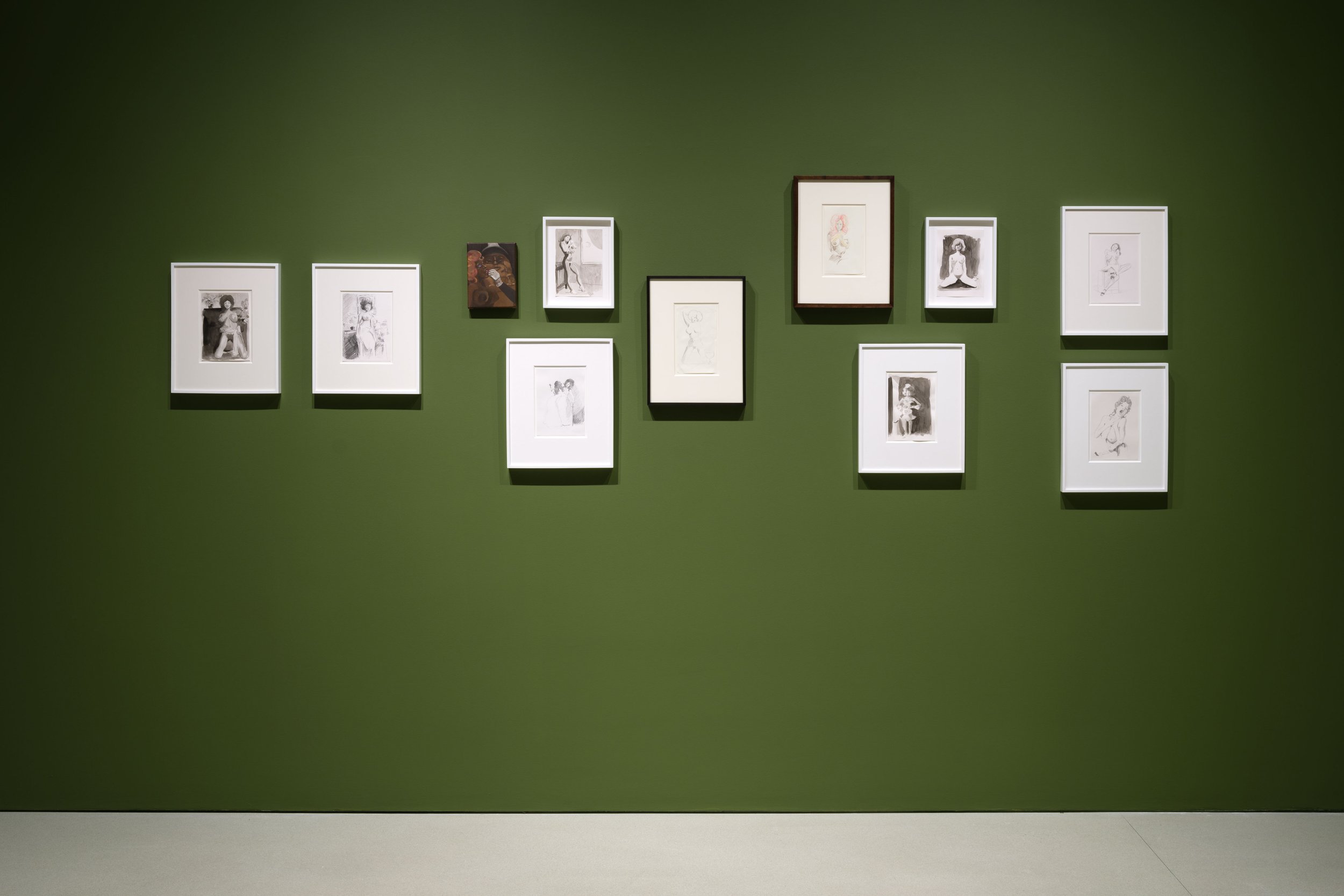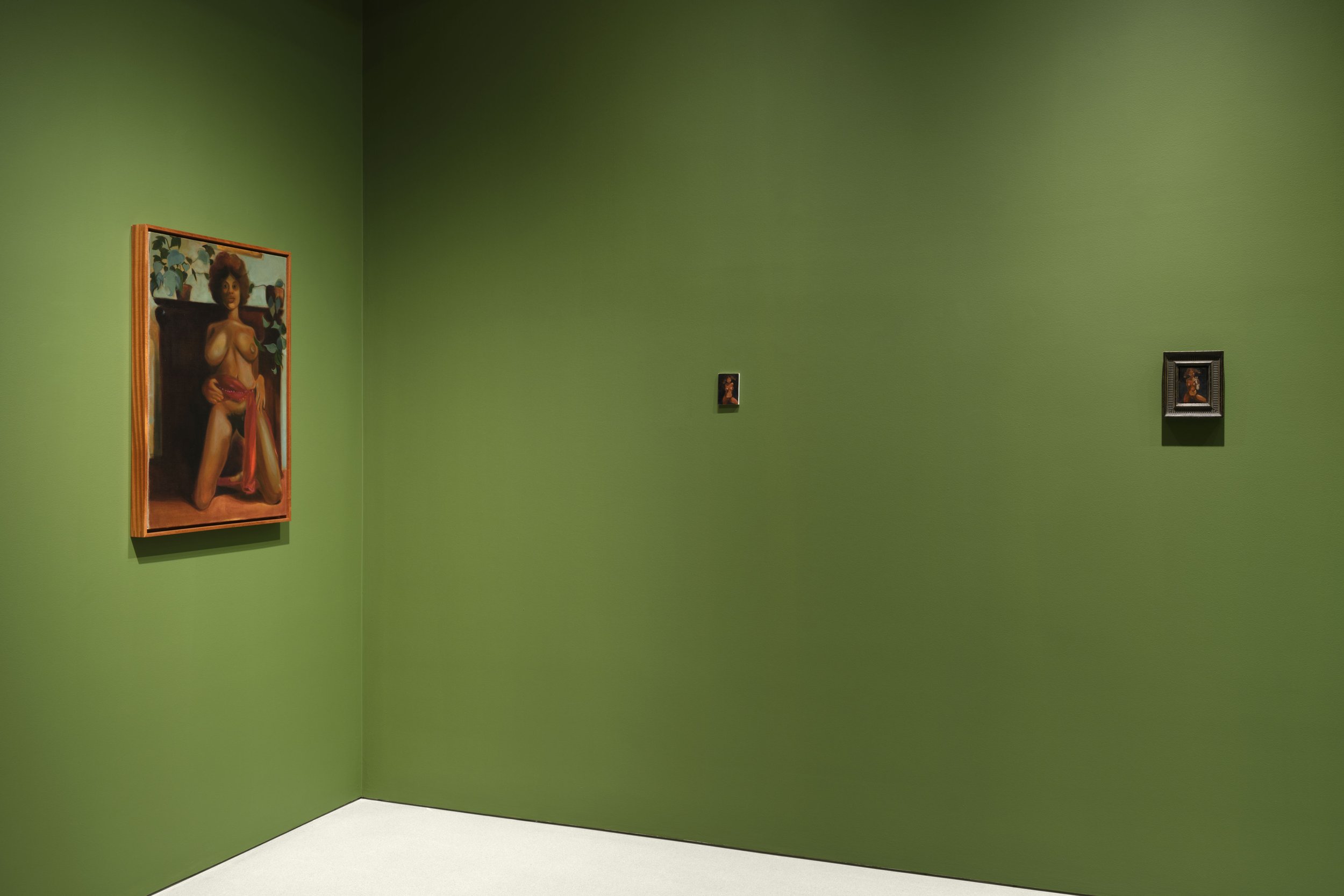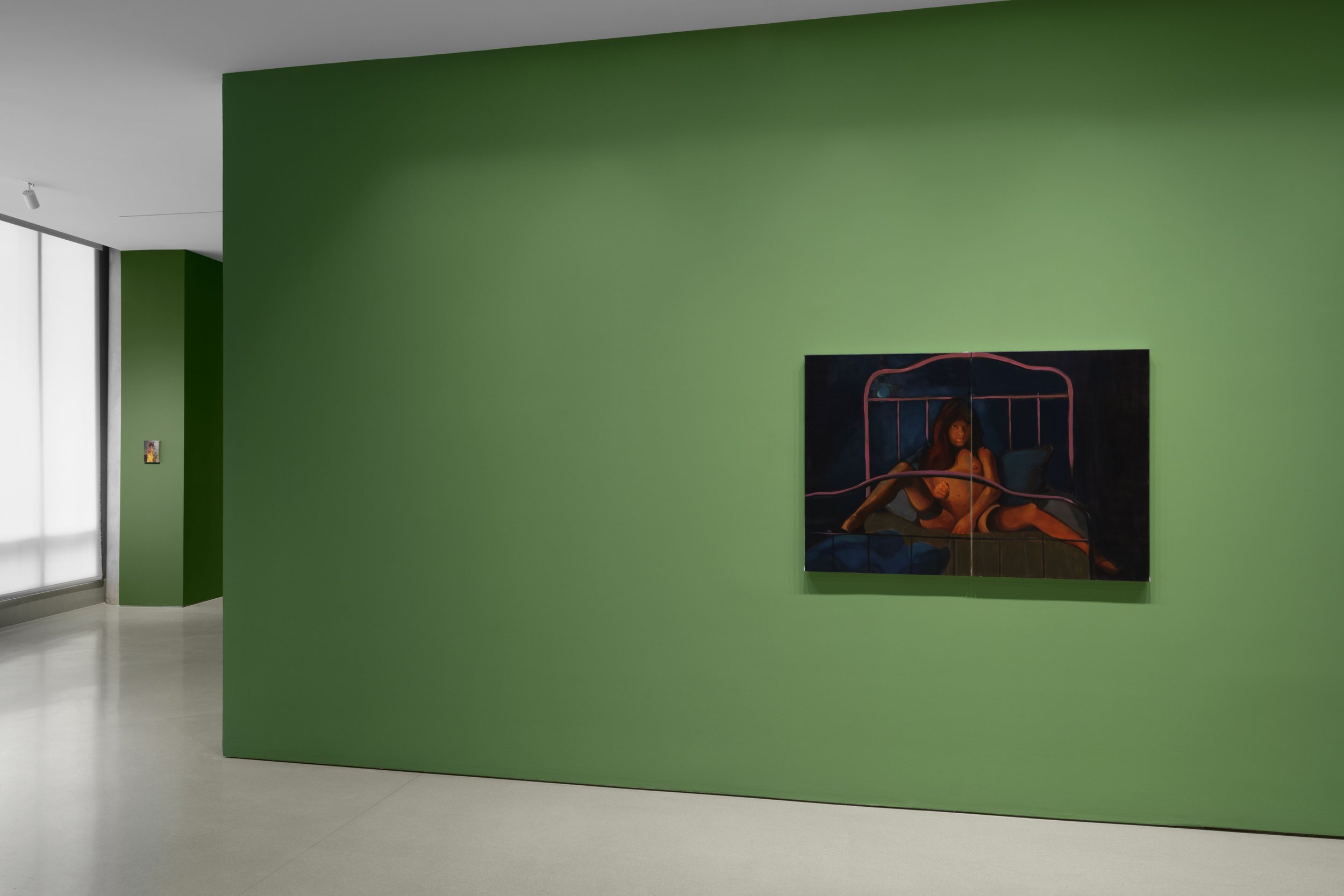Somaya Critchlow: Paintings and Drawings
APRIL1-JUNE 3, 2023
Somaya Critchlow: Paintings and Drawings, the British artist’s first institutional solo exhibition in the United States, features over thirty works created between 2018-22. Offering an expansive overview of Critchlow’s painting and drawing practices, the exhibition illustrates the development of her figures in earlier, intimately scaled artworks and more recent, medium-sized canvases. While the women she depicts are fictional, they draw inspiration from pop culture clichés, her own photographs, and studies from life. Critchlow’s subjects are both intriguing and unsettling; they seduce viewers into a world that at times references art historical and literary precedents, from a fishbowl borrowed from Balthus’s Le Poisson rouge, 1948, to French dramatist Jean Genet’s 1947 play, The Maids. While Critchlow’s handling of paint merges representation and abstraction, her imagery endlessly questions the complexities associated with image-making, the model, and perception.
Cutie Pie: On Somaya Critchlow: Paintings and Drawings at The FLAG Art Foundation
By Hilton Als
We are all imperfect bodies. But our dreams are perfect; in them, we run, leap, and fly (better, higher, faster than in the real world) to experience life as pure, free energy, unhindered by the corporeal and damning effects of time. Often dreams, or the longing for that kind of freedom, are particularly intense after a protracted period of illness or political repression. Surrealism and the Black Arts Movement—to name just two powerful aesthetic movements—took the cultural stage after the First World War and Malcolm X's 1968 assassination, respectively. Our current malaise, which has as much to do with a global pandemic and loss as it does with large-scale political maleficence, has also given rise to something new.
In 1951, the late, American-born painter and poet Dorothea Tanning created Interior with Sudden Joy. In this detailed, haunting piece, Tanning focuses on two female figures situated in an unidentifiable space, their arms around each other’s back. One of the young women pets the head of a shaggy dog, while the other looks toward a dark nude figure who clings to a tree or some other biomorphic shape. Beyond these three, another, non-gender-specific person stands in darkness, framed in an open doorway, and holds a light-filled sphere between their hands. Rendered in great detail, with particular emphasis on how light illuminates darkness and changes it, Interior with Sudden Joy is a depiction of the surprise and freedom that a work of art—or a dream—can generate. Painted at the start of what feels like a permanent Cold War, Tanning's work is a detail-rich explosion of energy and insight that grew out of a repressive time.
Could it be (and I hope it is) that Somaya Critchlow’s art is also an antidote to the awful years they were created in, which includes Brexit and the racism and xenophobia that helped produce it? No artist exists outside their time, and Brexit, followed by the pandemic, marked a particularly bad period in her native England and world history. When I look at Critchlow’s astonishing paintings and drawings—and my mind has not been able to turn away from them since I first saw her in a group show several years ago—I similarly see an artist who is making a world defined by energy, not just the energy that comes with being a corporeal being, but force.
Critchlow’s figures are forceful entities, often alive in their pleasure and the pleasure of being looked at, first by Critchlow, and perhaps another pair of eyes in that corner over there, just behind the girl in The Volleyball Intellectual (2019). You never know. Like a number of her other imagined subjects, it’s uncertain if the Critchlow woman needs “the gaze,” even if we like to imagine this possibility because, in the end, we associate that gaze with our own; the ego is not free from looking. Indeed, part of the story perception tells us as we look at this painting or a tree in nature is the story of ourselves—our dreams and desires. Critchlow’s figures don’t mind being looked at. That makes them feel alive in a prohibitive world where we can be “cancelled” if we say too much, see too much, eat too much, etc. Her characters are voluptuaries who make us feel that way too. They live inside their flesh and inside Critchlow’s imagination—a place you want to live in too. A place that reminds you that some of life’s pleasures involve the bodies we inhabit, the wonder of that, and the wonder of connecting to other humans in the process.
Critchlow’s characters often feel as though the artist has caught them in the act of waiting. And what are they waiting for? They reside in rooms seemingly by themselves, but they are not alone, they are single—a big difference. Alone implies loneliness, and that’s the last thing the gorgeous white-haired lady may feel in Obligation II (2019) as she luxuriates in her own flesh, first for herself, and then for our visual delectation. Would it be too much to say that, collectively, Critchlow’s work turns me on? Not in ways that are obvious, but in ways that have something to do with my history and how I first learned that there are joys attached to women and bodies not unlike those Critchlow depicts. In her images, nakedness is more than a right, it is a force. Part of the pleasure her women feel is our pleasure; they give to us; we do not take from them. There is no dialogue between the “male gaze” and the women you and I take such joys in looking at; they belong to their pleasure. Their pleasure. Their pleasure! Because we are shy and clothed in front of them, we take from them, and are in awe of them.
When I was a kid, the space underneath my uncle’s bed there was vast (his and his wife’s bed was very high up, or so it seemed to me when I was little) and crawling under it was like going on an expedition into a cave filled with known and unknown things. On the floor, you could find loose change and “dirty” magazines filled with page after page of beautiful women of color with their backs arched, or in swimsuits, or silk dresses with the tops pulled down, exposing us—the world—to their beautiful breasts with nipples on the verge of being erect. It was so much pleasure I could barely stand it; I had to close the magazines and run away. I was ashamed of the flush of excitement that threatened to overtake my entire body, and that’s the same pleasure-verging-on-embarrassment I felt when I first saw Critchlow’s work. The very existence of these women in your mind is political. As we crawl over broken glass and nails to get to a “deeper” understanding of repression, oppression, etc., Critchlow’s art gives us such beautiful pause. And then we remember: Ah, we also exist to connect the body to the mind!
Critchlow’s paintings and drawings not only show us a world of energized figures, but a world filled with the excitement to draw and paint their possibilities. The bodies depicted in this world seem to grow out of that most difficult shape: a round O that grows and grows to include breasts and a head. The artist discovers who a particular character is, or what she means, by making her. And then, we remake her in our own imaginations. Sometimes though, life gives these beautiful Critchlow women pause, like the one seen in Untitled (2022). What she contemplates, perhaps, is where life has led her and how paint has made her, simultaneously. Of course, she wouldn’t exist without Critchlow’s discerning, amused, and empathetic eye, but neither would we before her. We need to see her if only to remember that ecstasy is one kind of high, and that we live in reflection, too. Beyond the joys Critchlow’s paintings generate, I see an artist at work, lost in those joys and a sensuality that is almost embarrassing, except the artist's renderings are free of the smallness of that emotion.
About:
Somaya Critchlow (b. 1993, London, United Kingdom) is an artist living and working in London. Critchlow received a BA from the University of Brighton, United Kingdom, in 2016, before joining The Royal Drawing School, London, where she completed a Postgraduate Diploma in 2017. Recent solo exhibitions include Afternoon’s Darkness, Maximillian William, London (2022); Blow-Up, Galerie Gregor Staiger, Zürich, Switzerland (2021); Underneath a Bebop Moon, Maximillian William, London (2020); and Sincere for Synonym, Fortnight Institute, New York, NY (2019). Her work has been included in numerous group exhibitions, including The Story of Art as it's Still Being Written, Victoria Miro, London (2022); Women Painting Women, the Modern Art Museum of Fort Worth, TX (2022); Drawing Attention: Emerging British Artists, British Museum, London (2022); Fire Figure Fantasy, ICA Miami, FL (2022); among others. Critchlow’s work is included in the permanent collections of the Arts Council Collection, London; British Museum, London; Pallant House Gallery, Chichester, United Kingdom; Sainsbury Centre for Visual Art, Norwich, United Kingdom; Stedelijk Museum, Amsterdam, Netherlands; Baltimore Museum of Art, MD; LACMA, Los Angeles, CA; Carnegie Museum of Art, Pittsburgh, PA; Columbus Museum of Art, OH; Hammer Museum, Los Angeles, CA; RISD Museum, Providence, RI; Henry Art Gallery at the University of Washington, Seattle, WA; and ICA Miami, FL.
Hilton Als (b. 1960, New York, NY) is a writer living in New York and California. He became a staff writer at The New Yorker in 1994. He began contributing to the magazine in 1989, writing pieces for ‘The Talk of the Town.’ Als was previously a staff writer for The Village Voice and an editor-at-large at Vibe. He has also written articles for The Nation, The Believer, The New York Review of Books, and 4Columns, among other publications. His first book, The Women, a meditation on gender, race, and personal identity, was published in 1996 (Farrar, Straus & Giroux). His most recent book, White Girls (McSweeney’s), discusses various narratives around race and gender and was nominated for a 2013 National Book Critics Circle Award in Criticism.
In 1997, the New York Association of Black Journalists awarded Als first prize in both Magazine Critique/Review and Magazine Arts and Entertainment. He was awarded a Guggenheim Fellowship for creative writing in 2000, the George Jean Nathan Award for Dramatic Criticism for 2002 to 2003, and a Windham-Campbell Prize for Nonfiction in 2016. In 2017, he was awarded the Pulitzer Prize for Criticism. The same year, he was the recipient of the Langston Hughes Medal. The honor celebrates writers from the African diaspora for their distinguished work. Previous honorees include James Baldwin and Toni Morrison.
In 2010, Als published Justin Bond/Jackie Curtis (After Dark Publishing), his second book. In 2015, he cocurated, with Anthony Elms, a retrospective of Christopher Knowles’s work at the Institute of Contemporary Art in Philadelphia. He is also the coauthor of Robert Gober: The Heart Is Not a Metaphor, the catalogue published on the occasion of Gober’s retrospective at The Museum of Modern Art, New York, in 2014. In 2016, he produced a six-month survey of art and text at The Artist’s Institute, New York, NY, and organized Desdemona for Celia by Hilton, an exhibition of work by Celia Paul, at The Metropolitan Opera’s Gallery Met in New York. His work was included in the group exhibition Looking Back: The Eleventh White Columns Annual in New York in 2017. The same year, Als curated the critically lauded exhibition Alice Neel, Uptown, which traveled from David Zwirner, New York, to Victoria Miro, London, and Venice. In 2019, Als presented God Made My Face: A Collective Portrait of James Baldwin at David Zwirner, New York. Recent exhibitions he has curated include She Who Is: Adrienne Kennedy and the Drama of Difference, Artists Space, New York (2020); Get Lifted!, Karma, New York (2021); and Frank Moore, David Zwirner, New York (2021). He is curating a series of three successive exhibitions for the Yale Center for British Art, New Haven, of the work of Celia Paul (2018), Lynette Yiadom-Boakye (2019), and Njideka Akunyili Crosby (2022).
Als is a Teaching Professor at the University of California, Berkeley and has taught at Columbia University School of the Arts; Princeton University; Smith College; University of California, Berkeley; Wellesley College; Wesleyan University; and the Yale School of Drama.
Somaya Critchlow: Paintings and Drawings was organized by The FLAG Art Foundation. FLAG would like to acknowledge the artist, institutional lenders (The Henry Art Gallery, ICA Miami, Pallant House Gallery, and RISD Museum), private lenders, and Maximillian William, London.
Press:
“…seductively unnerving paintings and drawings of women.”
“She [Critchlow] interweaves historical and contemporary innuendos, creating work that is at once progressive and timeless.”
—Cultured Magazine —Dodie Kazanjian, Vogue Magazine














